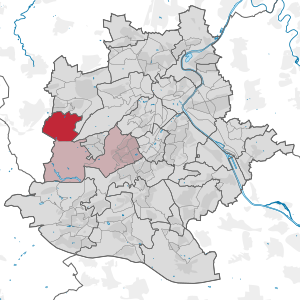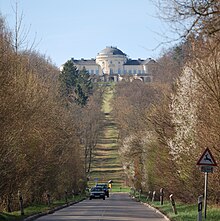Solitude
|
Solitude district of Stuttgart |
|
|---|---|
| Coordinates | 48 ° 47 '14 " N , 9 ° 5' 0" E |
| surface | 4.082 km² |
| Residents | 53 (May 31, 2020) |
| Population density | 13 inhabitants / km² |
| Post Code | 70197 |
| prefix | 0711 |
| Borough | Stuttgart-West |
| Source: Data Compass Stuttgart (PDF) | |
The Stuttgart district Solitude [ sɔlity: d ] is part of the Stuttgart-West district . It borders the Wildpark district, the Weilimdorf and Botnang districts , and the city of Gerlingen . It got its name from the Solitude Castle of the same name . Solitude Castle is located on the southwestern border of the Solitude district, which, like the Wildpark district adjacent to the south, consists mainly of forest. In the statistics, residents of these two districts are assigned to the district of Kräherwald .
history
In 1763, Duke Carl Eugen von Württemberg had his Solitude hunting lodge built. The associated hunting ground in the Leonberger Forest was expanded at that time and provided with pavilions and straight paths that were also intended as a field of fire. The farmers from the surrounding communities, especially the Weilimdorfer and Gerlingers, had to do labor for their duke in order to enable the castle to be built. In the short time that the duke spent at the castle, he celebrated festivals and organized large hunts with the nobility from all over Europe. Until Carl Eugen lost interest in his summer residence in 1775 and moved it to Hohenheim on the Fildern, Solitude also remained the domicile of the Karlsschule, which had been located here since 1770 (which was only elevated to university in 1781 as the Hohe Karlsschule in Stuttgart) and the place of residence of their students and faculty. Even Friedrich von Schiller spent some time as a student (apprentice) at Solitude. His father, Johann Caspar Schiller , became head of the ducal court gardens at Solitude Palace in 1775 . Later the site was less used and the gardens fell into disrepair. The Eberhard Church was demolished and rebuilt at its current location on Königstrasse in Stuttgart.
Only in the 19th century did interest in the castle reappear. This time mostly townspeople came on Sunday to spend their day at the castle. This was made easier after the Solitude was connected to the public transport of the capital with the bus line L of the Stuttgart motor vehicle lines . After the area of the Solitude Palace with its entire residential area belonged to the municipality (now the city ) of Gerlingen (Württemberg) from 1852/1858 to 1942 , it was incorporated into Stuttgart on April 1, 1942 and assigned to the Botnang district . The area of the sanatorium on the Schillerhöhe belonging to the Solitude residential area was returned to the Gerlingen community in 1951.
When the city of Stuttgart was divided into districts in 1956, the Solitude residential area was assigned to the newly established Stuttgart-West district and declared an independent district , which was not changed when the Stuttgart districts were reorganized on January 1, 2001. The Solitude district has only a few inhabitants.
Buildings
- Solitude Palace , built 1764–1769 under Duke Carl Eugen von Württemberg .
- Since 1990 , the Schloss Solitude Academy has been located in the outbuildings of the palace, the two office and cavalier buildings, and has set itself the task of promoting young artists.
- The Graevenitz Museum is housed in one of the gentleman's houses. It shows works by the Stuttgart sculptor Fritz von Graevenitz (1892–1959).
- The service villa of the Prime Minister of Baden-Württemberg, which was built at the end of the 1960s in place of an earlier castle barn, is located in the immediate vicinity of the castle.
- On the road to Weilimdorf, near the castle, there is a small cemetery, including the graves of the choreographer John Cranko , the Weizsäcker family and the sculptor Fritz von Graevenitz.
The Solitudeallee
The dead straight Solitudeallee begins at the northern main gate of the palace . Duke Carl Eugen had it built in 1764–1768 as a connecting axis to the residential palace in Ludwigsburg .
It leads through Weilimdorf and past Korntal , Zuffenhausen , Stammheim and Kornwestheim . It is still almost completely preserved today, partly as an asphalt dirt road. Only in Weilimdorf, where it coincides with the main street, and in Ludwigsburg, where the railway site interrupts the straight course, is there a slight offset in each case.
It served as the base line for the Württemberg land survey of 1820 and, according to the plaque inside the palace, is exactly 40,118.718 Parisian feet or 13,032.14 meters long.
The Solitude Grand Prix racetrack
As early as 1903, Schloss Solitude was the destination of a hill climb. In later years, the area around the castle was used as a paddock for circuit races with various challenging routes in hilly terrain.
From 1935 to 1965, the 11.3-kilometer Solitude race track south of the castle was used for Solitude races (including World Championship races) and Formula 1 races (without World Championship status). These races took place in front of 288,000 spectators on average, but were no longer continued after 1966. In 2003 an anniversary event took place in and around the castle, in which vehicles and drivers from previous races participated, including several world champions. In 2004 a rally commemorative event was held on the occasion of the 50th anniversary.
Trivia
Large parts of the partly two-row chestnut tree population on Karlsplatz in Stuttgart (in 1980) come from the Kastanienallee leading to Solitude, which was thinned out for this purpose.
Web links
Individual evidence
- ↑ a b Stuttgart data compass: City district West (PDF; 1.82 MB) State capital Stuttgart. 2012. Retrieved July 20, 2013.
- ↑ Dossier: The Summer Palace . State palaces and gardens of Baden-Württemberg. Retrieved July 20, 2013.
- ↑ To the best of his knowledge, this happened on the recommendation of the then Vice-Director of Rentkammer, his close friend Johann Christoph Dertinger (1731–1787), a nephew of the prelate Friedrich Christoph Oetinger . Cf. Reinhard Breymayer: Between Princess Antonia of Württemberg and Heinrich von Kleist's Käthchen von Heilbronn . News on the magnetic and tension fields of Prelate Friedrich Christoph Oetinger . Heck , Dußlingen 2010, p. 24 f .; see. S. 16. 48. 20. 62. 226. See Schiller's works. National Edition , Vol. 33, Part 1. Ed. By Siegfried Seidel. Weimar 1989, p. 39 f .: "Dearest son! [...] In addition to the fact that I wanted to inquire about his state of health at the moment, I inform him that our former Mr. Cammer-Director [Johann Christoph] Dertinger will soon follow suit Mannheim will come and inquire about him there. This is one of my best friends, and has shown me a great deal of friendship for the 33rd years that I've known him, and as far as I know, I was with Serenissimo [ie Duke Karl II. Eugene von Württemberg] for my post here. He my son may sincerely entrust himself to him, and ask for good advice, and if he cannot help himself, he has great acquaintance through which he can be useful to his friends in some way. [...] We hug and kiss him warmly His faithful father [Johann Caspar] Sch [iller]. " - See the comments ibid., Vol. 33, Part 2. Ed. By Georg Kurscheidt. Weimar 1998, p. 100 f ,; the register.
- ^ Hermann Lenz: Stuttgart - Portrait of a City . Insel Verlag , 2003.



